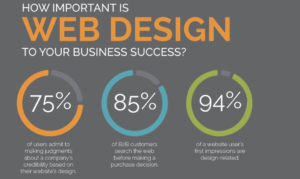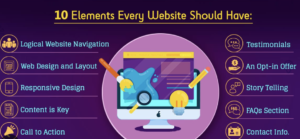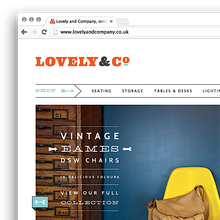Having a strong online presence is crucial for businesses of all sizes in today’s digital landscape. Your company website serves as the digital face of your brand, showcasing your products, services, and values to potential customers. In this comprehensive guide, I will share my expertise on how to build a stellar company website that captivates your audience and drives business growth.
Contents
- 1 Importance of a Company Website
- 2 Elements of a Great Company Website
- 3 Choosing the Right Domain Name
- 4 Website Design and User Experience
- 5 Optimizing Your Website for Search Engines
- 6 Mobile Responsiveness and Compatibility
- 7 Creating Compelling and Informative Content
- 8 Integrating Social Media and Other Marketing Channels
- 9 Website Analytics and Tracking
- 10 Regular Website Maintenance and Updates
- 11 Hiring a Professional Web Design Company
- 12 Conclusion
Importance of a Company Website
In the modern business world, a company website is no longer a luxury, but a necessity. Your website serves as the primary hub for your online presence, allowing you to:
- Establish Brand Identity: Your website is the first touchpoint for many potential customers, and it’s crucial to make a lasting impression. A well-designed, informative website helps you establish your brand’s identity, values, and unique selling proposition.
- Showcase Products and Services: Your website is the perfect platform to showcase your products and services in detail, providing your customers with all the information they need to make informed purchasing decisions.
- Improve Customer Engagement: A well-designed website can enhance customer engagement by offering interactive features, educational content, and seamless navigation, ultimately fostering a stronger connection between your brand and your audience.
- Boost Online Visibility: A search engine-optimized website can significantly improve your online visibility, making it easier for potential customers to find and engage with your business.
- Generate Leads and Sales: An effective company website can serve as a powerful lead generation and sales tool, driving conversions and boosting your bottom line.

Importance of a Company Website
Elements of a Great Company Website
Building a stellar company website involves carefully considering a range of elements to ensure a cohesive and user-friendly experience. Here are some key components to focus on:
Responsive Design
In today’s mobile-first world, it’s essential that your website is designed to be responsive and optimized for seamless viewing across a variety of devices, including smartphones, tablets, and desktops.
Your website’s navigation should be straightforward and intuitive, allowing users to quickly find the information they need without getting lost or frustrated.
Visually Appealing Aesthetics
The visual design of your website should be clean, modern, and aligned with your brand’s identity. This includes the use of high-quality imagery, consistent branding, and a cohesive color scheme.
Informative and Engaging Content
Your website’s content should be informative, engaging, and tailored to the needs and interests of your target audience. This may include product descriptions, company history, blog posts, and customer testimonials.
Secure and Reliable Infrastructure
Ensuring the security and reliability of your website is crucial for building trust with your customers and protecting sensitive information.
Seamless User Experience
The overall user experience of your website should be smooth and intuitive, allowing visitors to easily navigate, find the information they need, and take desired actions.

Elements of a Great Company Website
Choosing the Right Domain Name
The domain name you choose for your company website is an important decision that can have a significant impact on your online visibility and brand recognition. When selecting a domain name, consider the following factors:
- Relevance: Choose a domain name that accurately reflects your business and its offerings.
- Memorability: Opt for a domain name that is easy to remember and spell.
- Availability: Ensure that the domain name you want is available and not already in use by another company.
- Extension: While the traditional “.com” extension is often preferred, you may also consider alternative extensions like “.net” or “.biz” if the “.com” version is unavailable.
Website Design and User Experience
The design and user experience of your company website are crucial for engaging your audience and driving conversions. When designing your website, focus on the following elements:
- Layout and Navigation: Ensure that your website’s layout is clean, intuitive, and easy to navigate, with clear calls-to-action and intuitive menu structures.
- Visual Branding: Incorporate your brand’s visual identity, including colors, typography, and imagery, to create a cohesive and memorable user experience.
- Responsive Design: Ensure that your website is optimized for seamless viewing and interaction across all devices, from desktops to mobile phones.
- Accessibility: Design your website with accessibility in mind, ensuring that it can be easily navigated and understood by users with disabilities.

Website Design and User Experience
Optimizing Your Website for Search Engines
Search engine optimization (SEO) is the process of improving your website’s visibility and ranking in search engine results pages (SERPs). By optimizing your website for search engines, you can attract more organic traffic and increase the likelihood of potential customers finding and engaging with your business. Key SEO strategies to consider include:
- Keyword Research: Identify the most relevant and high-performing keywords for your business, and incorporate them strategically throughout your website’s content and metadata.
- On-Page Optimization: Ensure that your website’s content, structure, and technical elements are optimized to signal relevance and authority to search engines.
- Off-Page Optimization: Build a strong backlink profile by acquiring high-quality, relevant links from other reputable websites.
- Ongoing Monitoring and Refinement: Regularly monitor your website’s SEO performance and make adjustments to your strategy as needed.
Mobile Responsiveness and Compatibility
In today’s mobile-centric world, it’s essential that your company website is optimized for seamless viewing and interaction on a wide range of devices. To ensure mobile responsiveness and compatibility, consider the following:
- Responsive Design: Ensure that your website’s layout and content automatically adjust to provide an optimal user experience on mobile devices.
- Mobile-Friendly Content: Optimize your website’s content, including images, videos, and forms, to load quickly and function smoothly on mobile devices.
- Mobile-Specific Features: Incorporate mobile-friendly features, such as click-to-call buttons and location-based services, to enhance the user experience for mobile visitors.
- Mobile-First Approach: When designing and developing your website, adopt a mobile-first mindset to ensure that your website is optimized for the growing mobile audience.
Creating Compelling and Informative Content
Your company website’s content is a crucial element in engaging your audience and communicating your brand’s value proposition. To create compelling and informative content, consider the following strategies:
- Understand Your Audience: Conduct thorough research to understand the needs, pain points, and interests of your target audience, and tailor your content accordingly.
- Showcase Your Expertise: Demonstrate your industry expertise and thought leadership by creating high-quality, informative content, such as blog posts, whitepapers, and case studies.
- Maintain Consistency: Ensure that your website’s content is consistent in tone, style, and messaging, reinforcing your brand’s identity and values.
- Optimize for Readability: Structure your content in a clear and easy-to-scan format, using headings, bullet points, and concise language to enhance the user experience.
Integrating Social Media and Other Marketing Channels
In today’s digital landscape, it’s essential to integrate your company website with your social media and other marketing channels to create a cohesive and seamless customer experience. Consider the following strategies:
- Social Media Integration: Prominently display your social media profiles on your website and encourage visitors to follow and engage with your brand on these platforms.
- Content Sharing: Make it easy for your website visitors to share your content on their social media channels, amplifying your reach and engagement.
- Cross-Promotional Campaigns: Coordinate your website content and marketing efforts with your social media and other marketing channels to create a cohesive and impactful brand presence.
- Omnichannel Approach: Ensure that your website seamlessly integrates with your other marketing channels, such as email, SMS, and online advertising, to provide a consistent and personalized customer experience.
Website Analytics and Tracking
Regularly monitoring and analyzing your company website’s performance is crucial for understanding your audience, optimizing your content and marketing strategies, and driving business growth. Consider the following website analytics and tracking strategies:
- Google Analytics: Implement Google Analytics on your website to track key metrics such as website traffic, user behavior, and conversion rates.
- Conversion Tracking: Set up conversion tracking to measure the effectiveness of your website’s calls-to-action and sales funnel.
- A/B Testing: Conduct A/B testing to compare the performance of different website elements, such as landing pages, forms, and calls-to-action, and make data-driven decisions to optimize your website.
- Heatmap and Clickmap Analysis: Use heatmap and clickmap tools to visualize how users interact with your website, identifying areas of high engagement and potential friction points.
Regular Website Maintenance and Updates
Maintaining and regularly updating your company website is essential for ensuring its continued effectiveness, security, and relevance. Consider the following website maintenance and update strategies:
- Content Updates: Regularly review and update your website’s content to ensure that it remains accurate, relevant, and engaging for your audience.
- Technical Maintenance: Regularly perform website maintenance tasks, such as software updates, security patches, and server maintenance, to ensure the ongoing reliability and performance of your website.
- Design Refreshes: Periodically review and refresh your website’s design to keep it aligned with your brand’s evolving identity and the latest design trends.
- Performance Optimization: Continuously monitor and optimize your website’s performance, including page loading times and user experience, to provide a seamless user experience.
Hiring a Professional Web Design Company
While it’s possible to build and maintain a company website in-house, hiring a professional web design company can offer numerous benefits, including:
- Expertise and Experience: Professional web design companies have the expertise and experience to create a high-quality, user-friendly website that aligns with your brand and business goals.
- Efficient Project Management: Web design companies can handle the entire website development process, from planning and design to implementation and ongoing maintenance, freeing up your internal resources.
- Access to the Latest Technologies: Professional web design companies stay up-to-date with the latest web design trends, technologies, and best practices, ensuring that your website remains competitive and effective.
- Ongoing Support and Maintenance: Many web design companies offer ongoing support and maintenance services, ensuring that your website remains secure, up-to-date, and optimized for performance.
If you’re ready to take your company’s online presence to the next level, contact our team of expert web designers today. We’ll work with you to create a custom, high-performing website that aligns with your brand and drives business growth. Get in touch now to schedule a consultation and learn more about our services.
Conclusion
Building a stellar company website is a critical investment in the long-term success of your business. By focusing on the key elements discussed in this guide, you can create a website that not only reflects your brand’s identity but also engages your target audience, improves your online visibility, and drives business growth. Remember, a well-designed and optimized website is an invaluable asset in today’s digital landscape, and it’s worth the time and effort to get it right.
